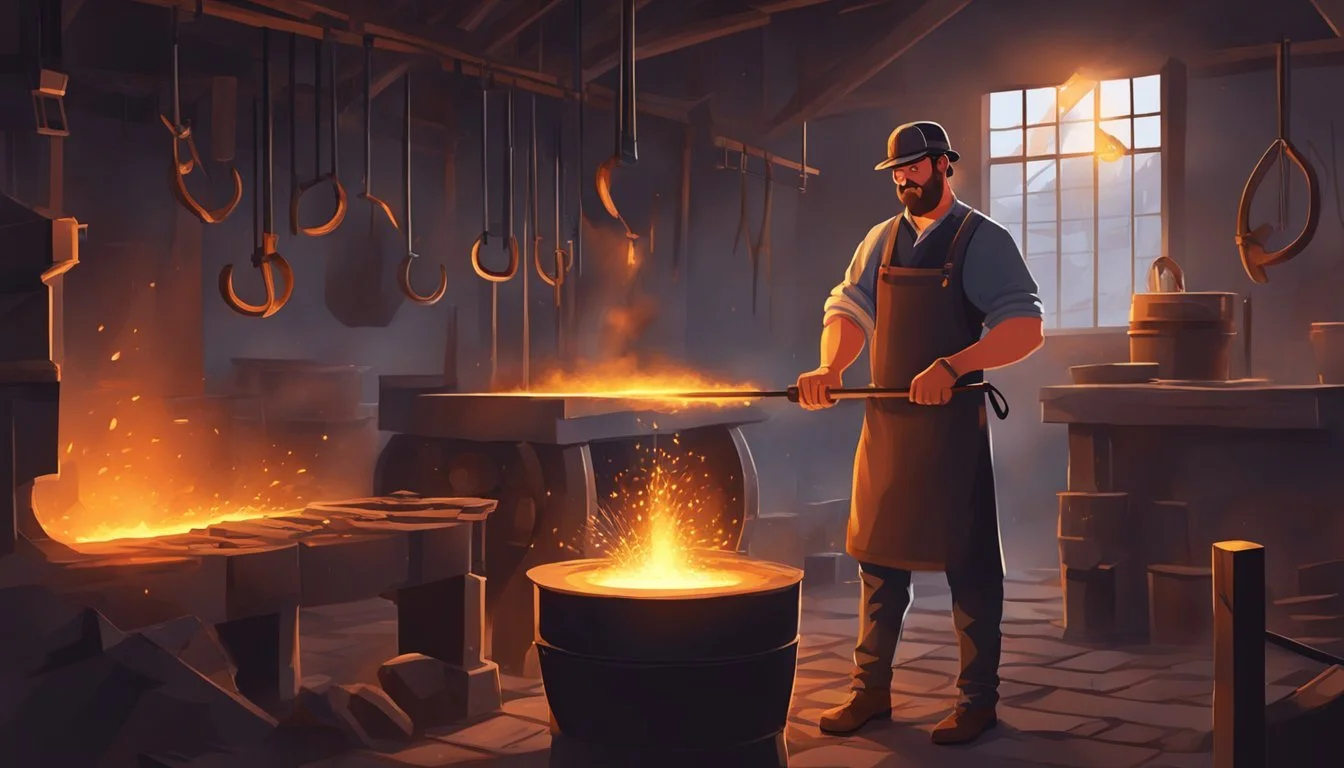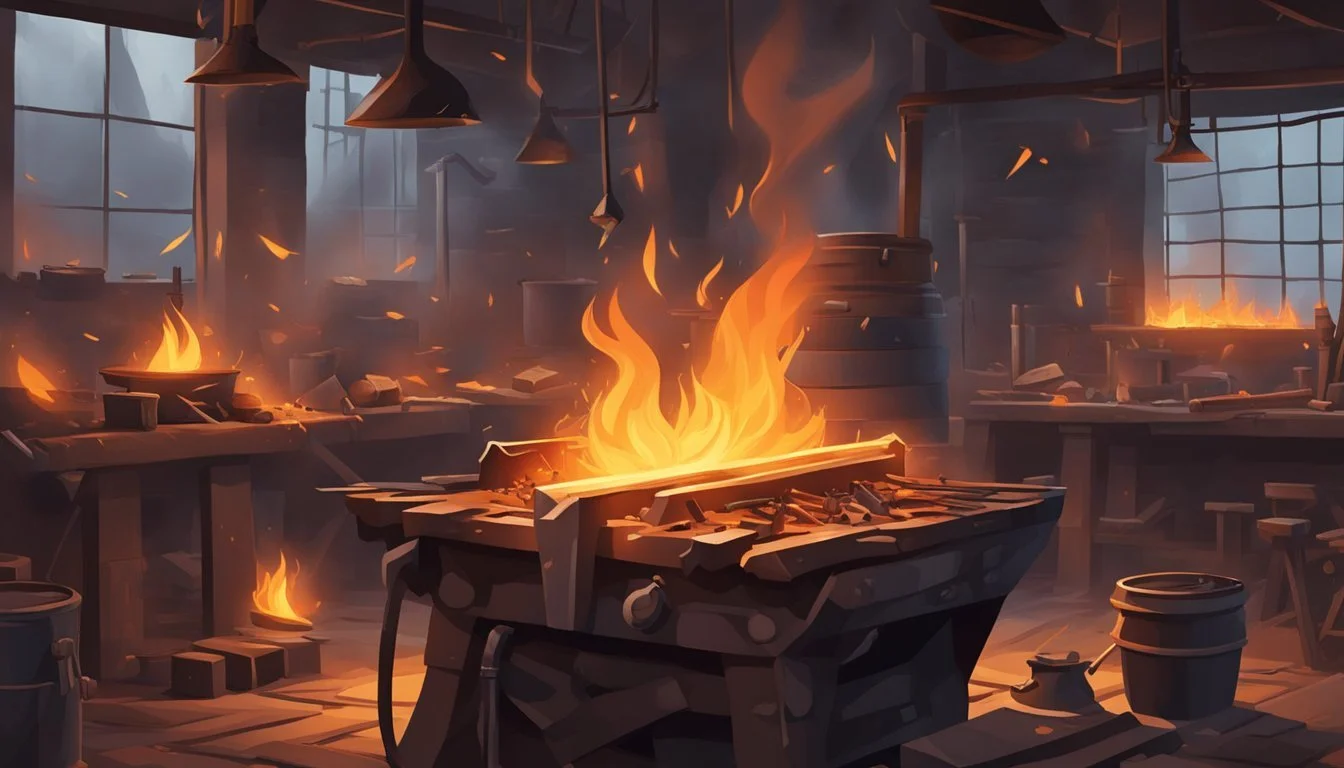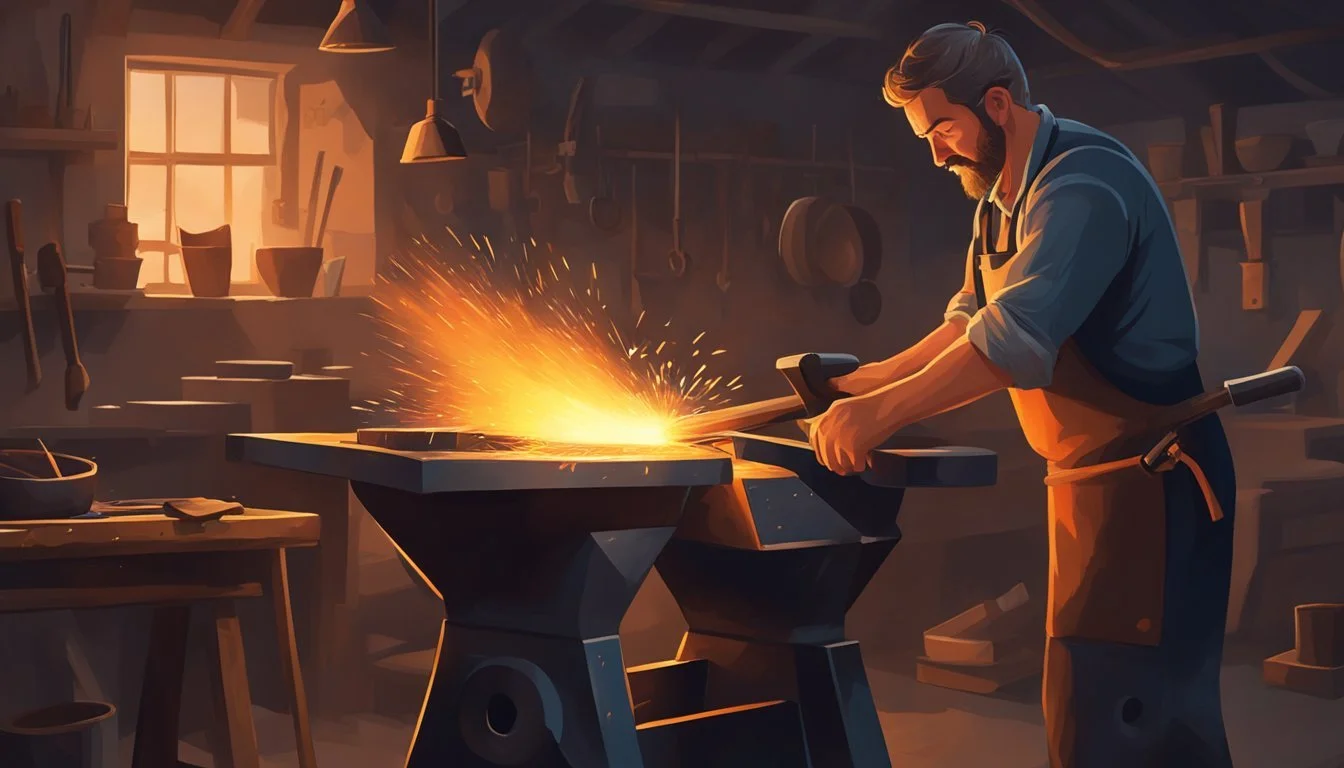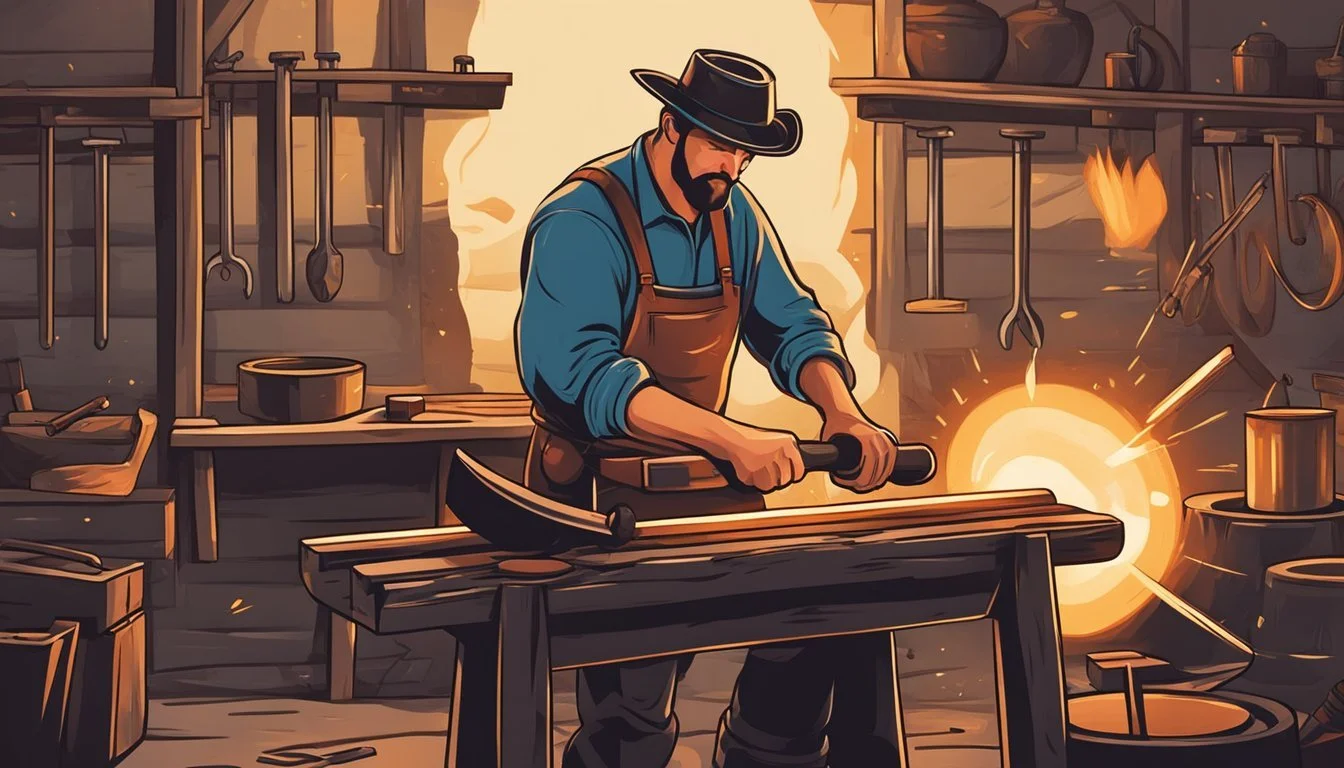The Revival of Cowboy Skills
Embracing Blacksmithing and Tool Making Traditions
The resurgence of interest in traditional cowboy skills, particularly blacksmithing and tool making, reflects a growing trend to reconnect with past craftsmanship. In the United States, blacksmithing was once a cornerstone trade, essential to the establishment and development of towns in the colonial era. Blacksmiths were regarded as vital members of the community, crafting a range of metal items from household utensils and tools to agricultural equipment.
With the onslaught of industrialization, the role of the traditional blacksmith diminished as mass-produced goods became the norm. However, recent years have seen a notable increase in those seeking to learn and master the craft. Modern blacksmith enthusiasts, often as hobbyists, are not only drawn to the historical aspect of the trade but also to the unique, hands-on experience of shaping metal.
This rekindled interest goes beyond mere nostalgia; it's a recognition of the inherent value and sustainability of handcrafted goods. Blacksmithing and tool making carry with them the tangible connection to the material and the maker, a quality seldom found in factory-produced items. This revival signals a broader appreciation for time-honored techniques and the enduring legacy of cowboy skills that shaped much of America's early infrastructure.
History and Legacy of Blacksmithing
Blacksmithing, an ancient trade, has dynamically evolved over centuries, marking its transition from a cornerstone of local economies to a craft cherished for its artistry in the modern day.
Ancient Roots and Early Blacksmiths
The craft of blacksmithing is deeply rooted in history, with the earliest instances of metalworking dating back to 1500 B.C. It began with the discovery of iron smelting and forging techniques by the Hittites—an ancient civilization known for advancing the use of iron. The fall of the Hittite empire dispersed this knowledge, laying the groundwork for blacksmithing across various cultures.
Industrial Revolution and Blacksmithing
The Industrial Revolution marked a pivotal turn for blacksmithing, altering its practice on a grand scale. The rise of mass production and factories in the 18th and 19th centuries led to the manufacturing of cast iron goods, significantly decreasing the need for hand-forged items. Specialized machinery introduced during this period shifted blacksmithing from a necessity to a specialized craft.
Pre-industrial: Handmade goods using traditional techniques
Post-industrial: Automated manufacturing processes
The Turn of Tradition to Modern Blacksmithing
In the present day, blacksmithing has seen a resurgence as both an artisan skill and a form of cultural heritage. While industrialization initially caused a decline, there has been a renewed interest in traditional blacksmithing techniques and the unique qualities of hand-forged metalwork.
Modern uses: Artistic expression, custom metalwork, historical reenactments
Legacy: Preservation of traditional skills, educational workshops, artisan communities
Despite the transformations over millennia, blacksmithing continues to be revered for its historical significance and maintained through passionate practitioners upholding its rich legacy.
The Art of Blacksmithing
Blacksmithing is a craft deeply rooted in history, focusing on the manipulation of metal through heat and tools. This section delves into the core skills, tools, and traditional techniques required for proficient blacksmithing.
Fundamental Blacksmithing Skills
The foundation of blacksmithing lies in an artisan's ability to work with basic materials and master essential processes. Key skills include:
Heating: Properly heating metals in a forge is crucial. The color of heated metal indicates its readiness for forging, with red to yellow hues being optimal.
Shaping: Blacksmiths use hammers and anvils to bend hot metal into desired forms.
Forge Welding: A technique to join two pieces of metal together in the forge.
Tools of the Trade
Blacksmiths rely on an array of tools, each serving a specific purpose:
Anvil: The central tool where most shaping occurs.
Hammers: Various hammers are used for different shaping techniques.
Tongs: Used to hold and manipulate hot metal safely.
Mastering Traditional Techniques
To achieve the title of a master blacksmith, one must be proficient in traditional blacksmithing techniques, practicing skills that require precision and patience:
Craftsmanship: Artisans take pride in the meticulous detail in their work, from intricate joinery to delicate finishes.
Traditional Techniques: These include scroll work, twisting, punching holes, and cutting, which are vital for creating complex items.
Through consistent practice and adherence to traditional methods, blacksmithing maintains its status as a respected craft, merging form and function in every piece an artisan creates.
Materials and Crafting Processes
In the realm of cowboy skills, blacksmithing and tool making are resurging practices that merge time-honored techniques with modern applications. The choice of materials and the processes are essential for crafting durable and functional items.
Understanding Iron and Steel
Blacksmithing traditionally revolves around the use of iron and its derivative, steel. While iron is a malleable and ductile metal, steel is an alloy consisting primarily of iron with varying carbon content, which lends it strength. Here, knowing the distinction is vital: wrought iron, with its low carbon content, is more resistant to corrosion and has a grain resembling wood, used for decorative purposes. However, steel—preferred for its hardiness and the ability to hold a sharp edge—is extensively utilized in tools and weapon making.
Metal Type Carbon Content Characteristics Pure Iron Low (<0.08%) Soft, ductile, malleable Wrought Iron Low (<0.35%) Wood-like grain, malleable Steel Variable (0.2% to 2.1%) Durable, hard, may be brittle
The Role of Heat in Shaping Metal
Heat plays a pivotal role in blacksmithing processes. At a blacksmith's forge, metals are heated until they reach a malleable state where they can be effectively shaped. Hot metal glows from red to yellow depending on the temperature, indicating its readiness to be worked. The blacksmith heats the metal to a specific temperature to increase its malleability without melting it. It's a delicate balance—the correct heat allows the artisan to manipulate metal with precision to achieve the desired form, be it bending, cutting, or joining.
Red heat: ~900°F - 1,300°F (suitable for softer shaping processes)
Orange heat: ~1,300°F - 1,500°F (ideal for more strenuous shaping)
Yellow heat: ~1,500°F - 2,000°F (optimal for welding and forging)
Subsequently, controlling the temperature and understanding the behavior of iron and steel under different conditions are crucial for the blacksmith. Mastery over these materials and processes is what turns raw metal into tools and artistry emblematic of cowboy resilience and ingenuity.
Cultural Significance and Community
The revival of blacksmithing brings forward a blend of tradition and art that anchors it deeply within communities. This craft not only fosters a sense of continuity from the past but also provides practical education and engagement for enthusiasts of all ages.
Blacksmiths as Pioneers and Artists
Blacksmiths were historically instrumental in shaping the growth of civilizations. They are often seen as pioneers who advanced tool making and metalworking techniques essential for the development of society. Today, blacksmithing is recognized as both a profession and an art form. Artisans meticulously work metal into functional items and artistic pieces, demonstrating their technical skills and creativity. The role has evolved to embrace the aesthetic aspect, with blacksmiths creating ornamental work that is admired and valued for its craftsmanship.
Community Involvement and Education
Blacksmithing serves a central role in community building by offering a space for individuals to learn and participate in a shared heritage. Classes and workshops provide hands-on experience and education in metalwork skills, often organized by local groups or blacksmith organizations. Participants range from complete novices to skilled enthusiasts eager to refine their craft and pass on knowledge.
Local community events often feature blacksmithing demonstrations, sparking interest and appreciation for the skill.
Education in blacksmithing fosters technical know-how and an understanding of metallurgical principles in a community setting.
Organizations Promoting Blacksmithing
A number of dedicated organizations work to promote blacksmithing and link those passionate about the trade. The Artist-Blacksmith's Association of North America (ABANA) is instrumental in this revival, uniting blacksmiths across the continent through conferences, publications, and educational initiatives. They aim to preserve traditional techniques while also inspiring innovation in the craft.
ABANA offers a resource platform for enthusiasts to connect and share knowledge, helping to maintain the tradition and vitality of blacksmithing.
Local chapters of national organizations help in bringing together blacksmiths to collaborate, learn, and educate others within their own communities.
Revival and the Modern Movement
In the past decade, there has been a notable increase in blacksmithing enthusiasts who find both challenge and opportunity in the ancient craft. This resurgence has placed blacksmithing at a unique intersection of hobby and profession.
Challenges and Opportunities in Contemporary Blacksmithing
Contemporary blacksmiths confront a dual landscape: while traditional skills are in less industrial demand, modern blacksmithing thrives on resilience and innovation. Access to resources and training presents hurdles; however, successful practitioners often combine self-taught skills with formal apprenticeships. This blend of old and new learning methods is vital for the craft’s survival and growth.
The availability of modern tools and techniques has also allowed blacksmiths to create more intricate and diverse products than ever before. Online platforms offer these artisans greater visibility, which helps to generate both interest and income. The profession has evolved, encompassing everything from practical tool-making to intricate decorative work.
Blacksmithing as a Hobby and Profession
Blacksmithing as a hobby:
Enthusiasts: A varied demographic, from young makers to retired individuals seeking a satisfying pastime.
Skills: Hobbyists often learn through local courses, workshops, and a growing number of online tutorials.
Community: Local and online communities foster a sense of belonging, providing inspiration and support.
Blacksmithing as a profession:
Demand: Custom, hand-forged items are sought after for their uniqueness and quality.
Business Acumen: Professional blacksmiths must also be savvy entrepreneurs, marketing their craft and managing their business.
Adaptation: They frequently adapt to market trends, creating items that resonate with contemporary aesthetics.
The revival of blacksmithing has not only been instrumental in preserving an important aspect of cultural heritage but has also found relevance in contemporary society. Through this resurgence, the craft attracts those who are inspired by the tangible connection to material and the rhythmic dance of hammer and anvil.
Applying Blacksmithing Skills Today
Today's resurgence of blacksmithing sees the craft applying to both functional and aesthetic creations. Traditional skills are being harnessed for practical applications and artistic expressions that blend into modern lifestyles.
Practical Uses and Decorative Works
Blacksmiths contribute significantly to crafting functional art—items that serve a practical purpose while offering an aesthetic appeal. They create a variety of household items and kitchen utensils that combine durability and design, such as:
Wrought iron gates and railings that provide security with elegance.
Custom-made hinges and hardware adding a unique touch to homes.
Farm equipment that is robust and tailor-made to specific tasks.
Blacksmiths also extend their artistry to creating decorative pieces that double as functional art, like:
Sculptural pieces that serve as focal points in gardens or public spaces.
Fireplace tools and screens that blend functionality with craftsmanship.
Collaboration with Other Craftsmen and Architects
The blacksmith's skill set is highly valued in collaborative efforts with architects and other craftsmen. They work together to:
Develop bespoke architectural elements such as balconies, staircases, and lighting fixtures that reflect the visions of both the blacksmith and the architect.
Create custom tools that are specifically tailored to the artisans' requirements, enhancing their craftwork.
Collaborative projects often result in unique installations and functional art pieces that are bespoke to clients' desires, exemplifying a symbiosis of form and function.
Learning and Advancement in Blacksmithing
The journey to becoming a skilled blacksmith involves access to quality resources and progressive skill development, from a foundational apprentice level to achieving mastery status.
Resources and Workshops for Aspiring Blacksmiths
For those interested in the art of blacksmithing, a variety of resources are available to start their education. Workshops offer hands-on experience, often led by experienced blacksmiths, providing a direct and practical approach to learning.
Online Platforms: Many websites offer tutorials, video series, and community forums.
Books and Guides: Time-tested publications like "Blacksmith's Craft" provide in-depth knowledge on techniques and tools.
Organizations: Groups such as ABANA (Artist-Blacksmith's Association of North America) have curricula for both hobbyists and professional blacksmiths.
Local Blacksmithing Schools: They typically offer short-term courses and workshops for different skill levels.
From Apprentice to Master Blacksmith
The apprenticeship model remains core to blacksmithing, where an apprentice learns through hands-on experience under the guidance of a master blacksmith.
Stage Description Apprentice Learners commence with fundamentals, understanding iron's behavior and basic forging techniques. Journeyman Intermediate blacksmiths refine their skills and learn specialized techniques. Master Blacksmith After years of practice and advanced learning, blacksmiths reach mastery, often producing specialized and high-quality craftsmanship.
Advancement is marked by the ability to design and execute intricate works, understanding advanced metallurgy, and often, the ability to teach others adeptly.
The Future of Blacksmithing Industry
The blacksmithing industry is evolving through the integration of modern technologies and a shift towards sustainable practices. These advancements promise to redefine the traditional scope of metalworking and tool making.
Innovation and Technology in Metalworking
Innovations in the blacksmithing field have introduced advanced equipment and techniques, enhancing both efficiency and precision. Robotic technology, for instance, is making significant inroads, with systems like computer numerical control (CNC) overseeing many processes. This has transformed the craftsmanship by enabling the automation of complex tasks.
Bellows: Traditional bellows are now often replaced by electrical blowers, providing more consistent airflow.
Coal Forge to Gas Forges: The transition from coal to gas forges marks a significant leap. Gas forges offer enhanced control over the forging temperature and reduce harmful emissions, aligning with the industry's push for cleaner alternatives.
Sustainability and Blacksmithing
The industry is also witnessing a growing emphasis on sustainability. Blacksmiths are adopting practices to minimize their environmental impact, ensuring that the revival of these skills does not come at the cost of ecological balance.
Materials: There is an increasing use of recycled metals, reducing the demand for mining and raw materials.
Fuel: Gas forges are preferred not only for their efficiency but also because they can be powered by cleaner fuels, contributing to the industry's carbon footprint reduction.
The synergy of innovation and sustainability is propelling the blacksmithing industry into a future where traditional skills are preserved, yet practiced within the context of a modern, environmentally-conscious framework.
Marketplace and Business of Blacksmithing
The resurgence of blacksmithing has ushered in new market opportunities, primarily for artisans specializing in custom, handcrafted metalwork. The business revolves around unique skills in craftsmanship and personal relationships with customers.
Finding and Engaging with Customers
Blacksmiths showcase their unique ability to intertwine traditional skills with contemporary designs, attracting customers seeking personalized items. Craftsmanship is their primary offering, but strategies to engage customers include:
Participating in craft fairs and historical reenactment events.
Hosting live demonstrations to showcase the process and skill involved.
Utilizing social media platforms and online forums to connect with potential customers.
By focusing on these avenues, blacksmiths can engage with a clientele that values the quality and heritage of hand-forged items.
Marketing and Selling Handcrafted Metalworks
Effective marketing is critical in transforming blacksmithing from a craft into a sustainable business. Blacksmiths can employ the following strategies:
Developing an online presence with a portfolio showcasing a range of products, from everyday tools to bespoke artistic pieces.
Leveraging customer testimonials and word-of-mouth to build trust and authenticity in their brand.
Implementing search engine optimization (SEO) practices to increase visibility to those searching for handcrafted metalwork.
Selling these items involves not just craftsmanship but also an understanding of pricing strategies and market demand. Blacksmiths typically provide:
A catalog of products, with clear pricing, available through digital and physical channels.
Custom order options, where clients can request unique items suited to their specific needs.
In conclusion, the business side of blacksmithing requires a balance between artisanal skill and strategic marketing to thrive in today’s marketplace.








